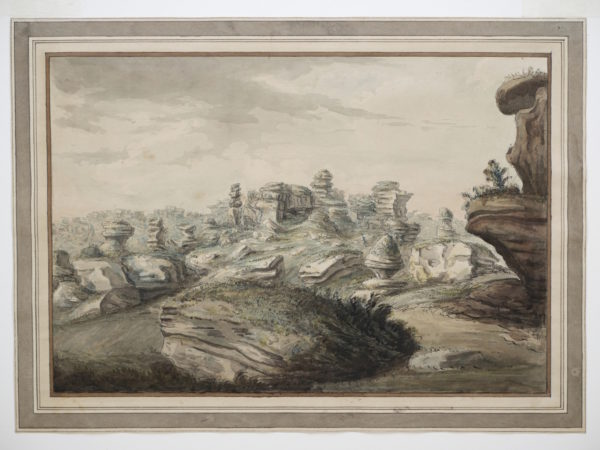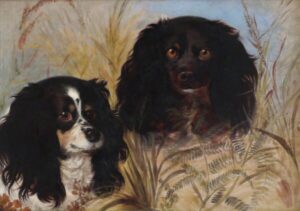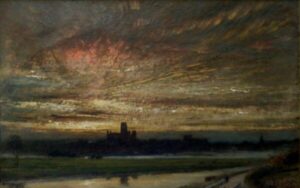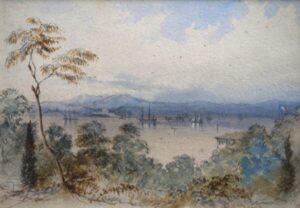Description
From 1733 to 1798 Griffith’s accompanied Thomas Pennant on several tours including from Alston Moor to Harrogate. An account is given in a version edited and published by David Pennant, under the title A Tour from Alston-Moor to Harrowgate and Brimham Crags; by Thomas Pennant, Esq. (London, 1804). The first part of the tour, undertaken in 1773, was ended when the travellers reached Knaresborough, and the second part of the journey, consisting of a visit to Harrogate, and thence to Ripley Hall and Brimham Crags, in the parish of Halifax, was not undertaken until 1777.
These unusual rock formations came about through glaciation and erosion from wind and rain of the millstone grit sandstone that is found in the area. Geologists have dated the rocks at around 320 million years old.
Over time nature has carved the rocks into weird and wonderful shapes, earning them nicknames such as the Sphinx, the Eagle, Idol rock, the Turtle, the Camel, and the Dancing Bear. The rock shapes we see today were most likely formed by erosion during the last glacial period, which occurred from around 110,000 to 10,000 years ago.
Thomas Pennant was born into an ancient Welsh family whose seat was Downing in Flintshire. He was interested in natural history from childhood and went up to Queen’s College, Oxford at the age of eighteen, touring Cornwall two years later to study fossils and minerals.
A noted naturalist, Pennant published important works on British and Indian zoology from 1766, the year before he was elected a Fellow of the Royal Society. But in British art he is better known as the employer of Moses Griffith, who became his personal servant in 1769 and ‘early took to the use of his pencil’ accompanying Pennant on his tours around North Wales, the Isle of Wight, and the Border counties. When Thomas Pennant died in in 1798, Griffith attempted to set himself up as an engraver, but soon began making Welsh views for Pennant’s son.
In 1846 Viscount Feilding (later 8th Earl of Denbigh) married Louisa Pennant. She was the great-granddaughter of the topographer Thomas Pennant, and inherited his house, Downing Hall, in Flintshire.
Brand
Griffith, Moses (1747-1819)
Born at Trygarn, Bryncroes, Caernarfonshire, 25 March 1747, and christened at Botwnnog church where he later attended the Free School kept by the rector, Richard Thomas. He received no further education, but in 1769 he was engaged by Thomas Pennant, who, discovering his aptitude as a draughtsman, employed him to illustrate his tours.
Pennant, in his Literary Life …, refers to Moses Griffith as 'an able artist ' who could also engrave and who was also 'tolerable skilled in music.' He accompanied Pennant on all his tours between 1769 and 1790. Engravings after his drawings were used to illustrate several of Pennant's published works, notably the accounts of his tours in Wales and Scotland. These, however, formed only a small part of Griffith's output as many more of his water-colour drawings of churches, country houses, and other scenes in England and Wales were used to enhance several extra-illustrated copies of Pennant's works.
In addition to these, Griffith was also responsible for many illustrations of animals, birds, and fishes used in Pennant's books on natural history. That he possessed also no mean skill as a portrait painter is evident from a study of the number of small scale sketches from life. After Pennant's death in 1798 Griffith was employed by his son David Pennant, and he executed a group of about 200 water-colours of Welsh views for him between 1805 and 1813. He was living at Whitford, near Holywell, in 1781 and married Margaret Jones of the same parish. There were two children of the marriage. A letter in The Gentleman's Magazine for December 1809 from Griffith shows that he then resided at Wibnant near Holywell; he died there 11 November 1819, and was buried at Whitford, 15 November 1819.
The National Library of Wales possesses many of his watercolours of Welsh scenes, churches, country houses, and portraits, including two self-portraits, as well as several extra-illustrated volumes of Pennant's works, containing in all several hundred original sketches and drawings by Griffith. The National Museum of Wales also possesses a collection of his watercolours, and his work is to be found in the British Museum and the Victoria and Albert Museum.



